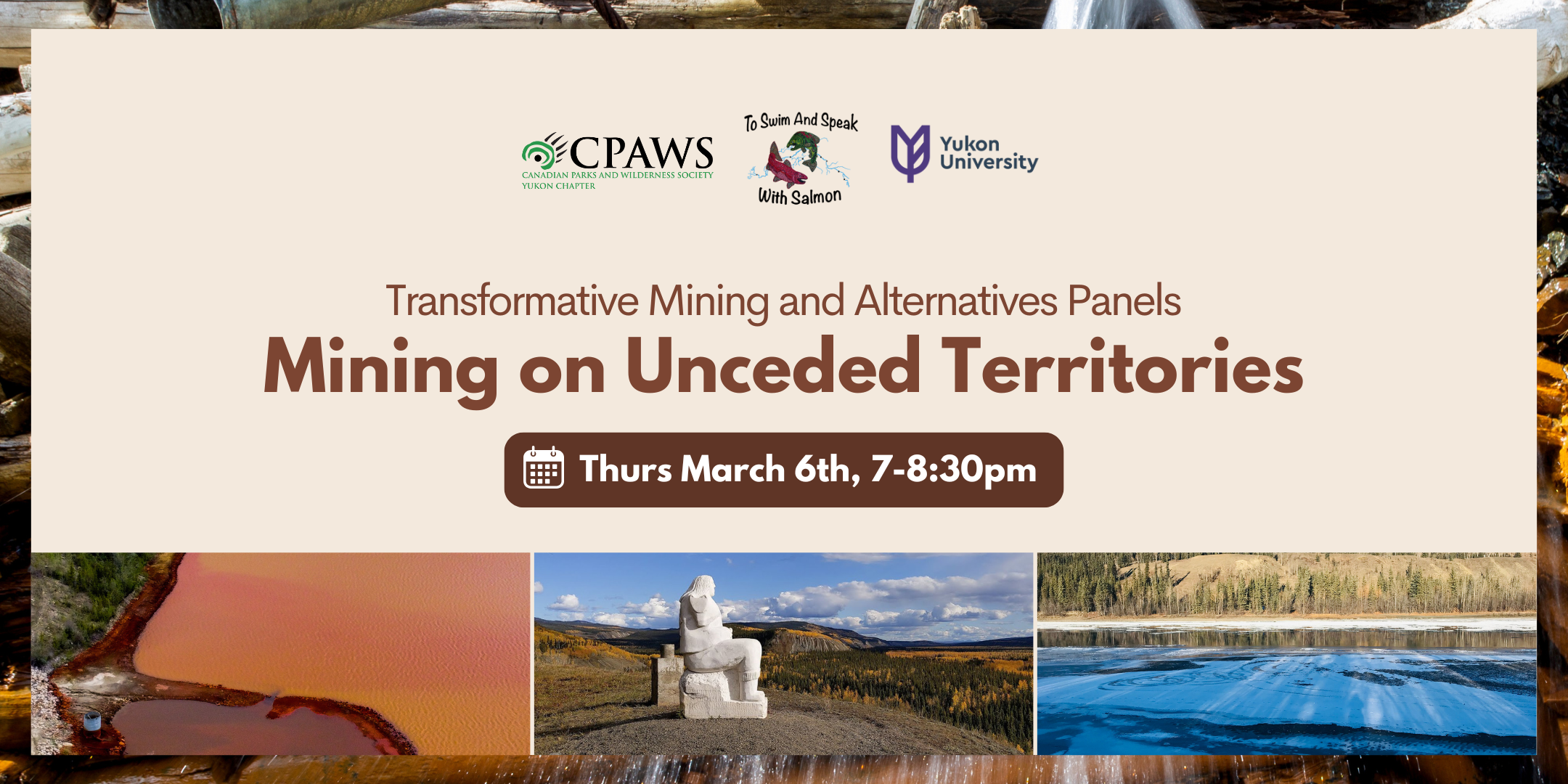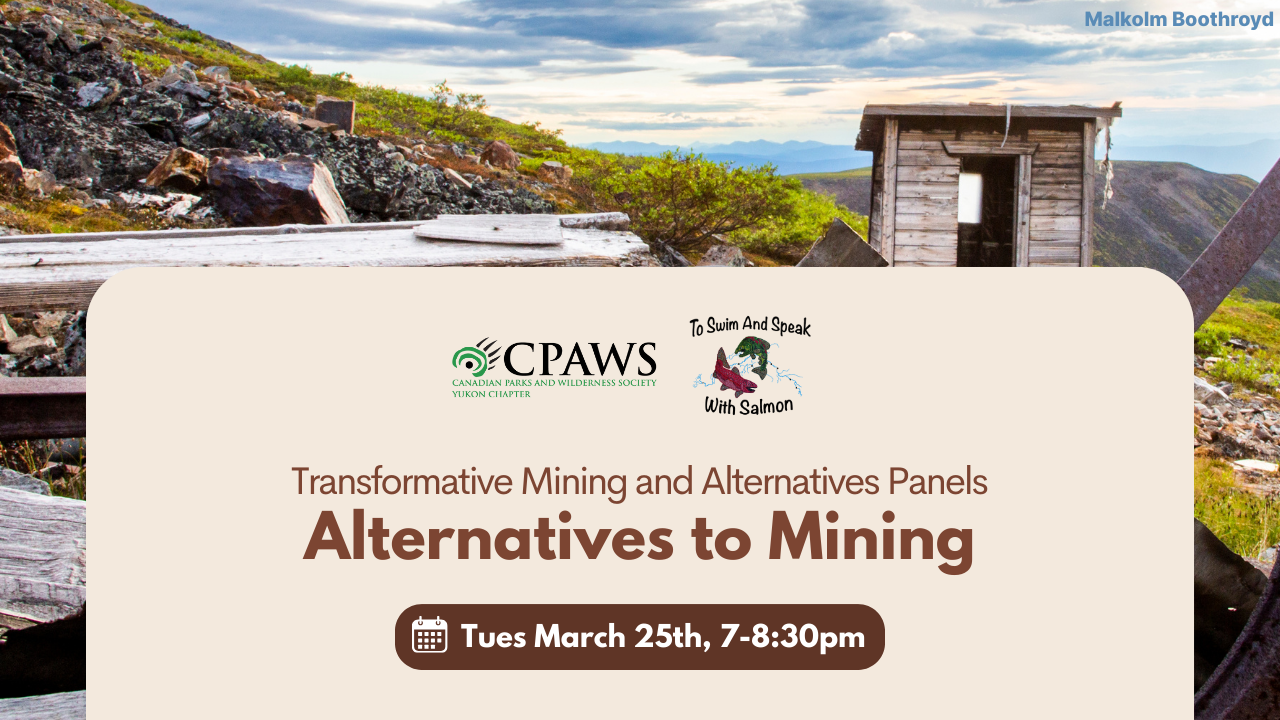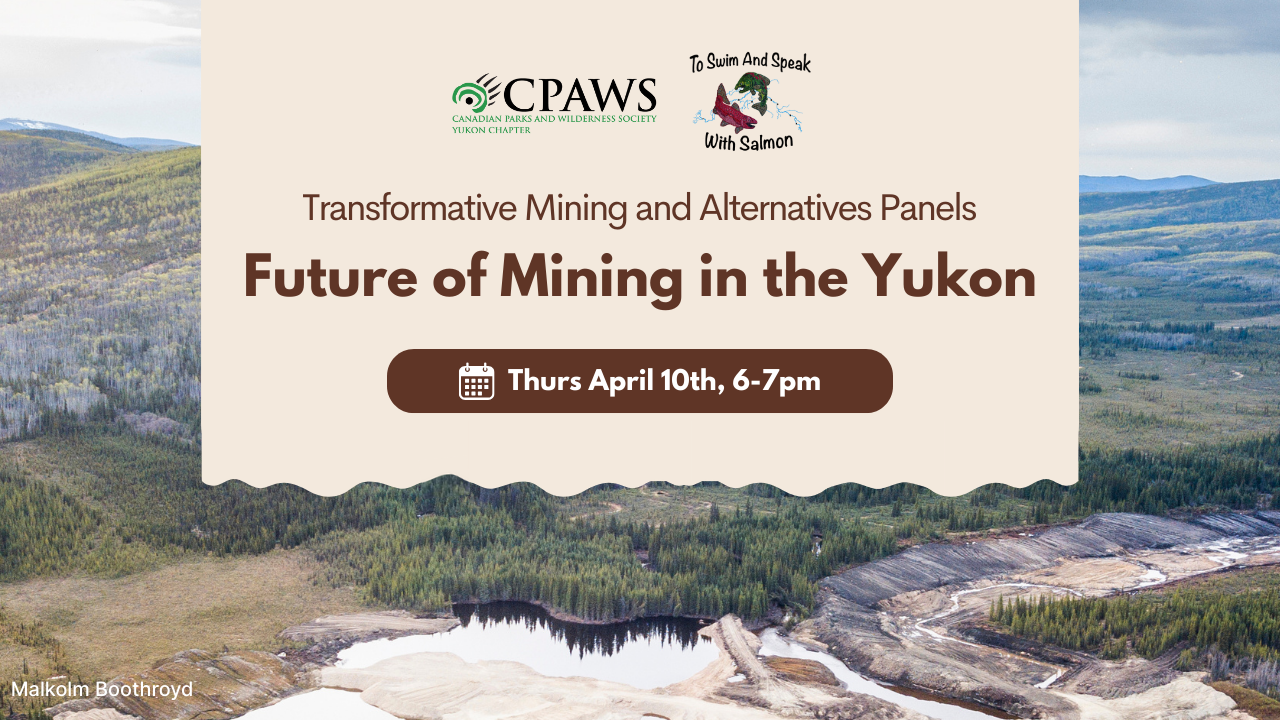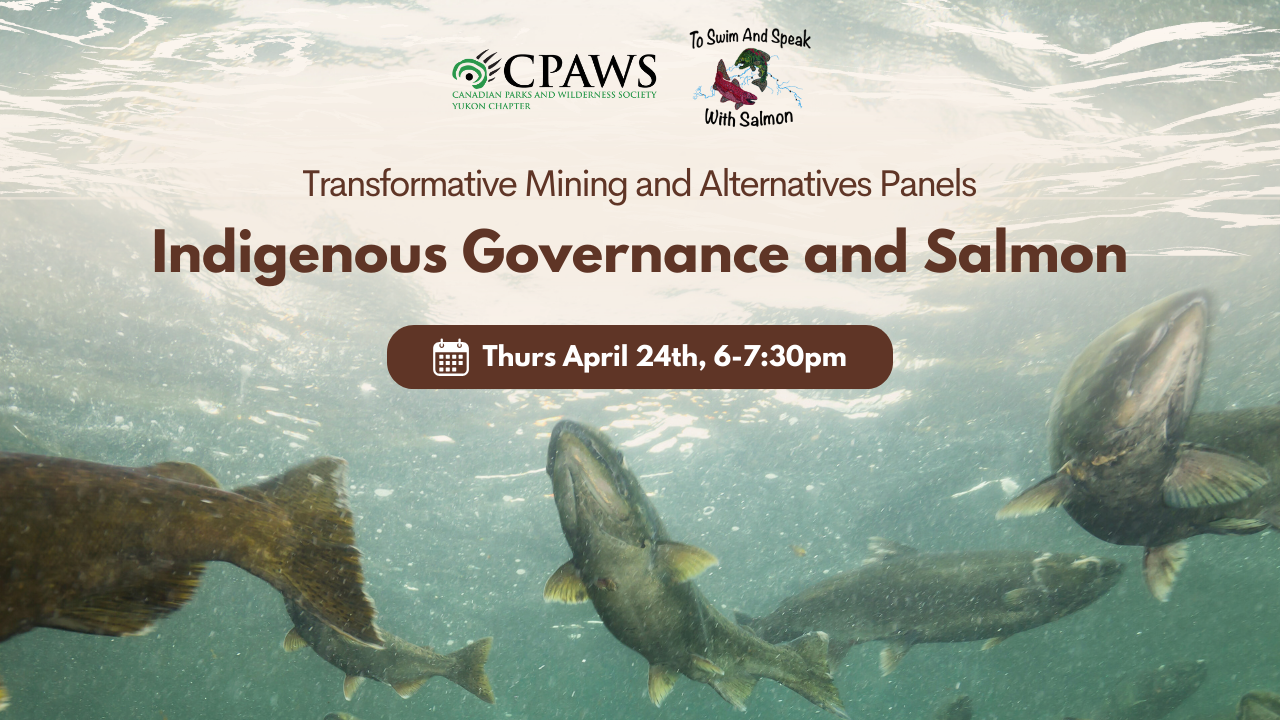Future of Mining in the Yukon
Transformative Mining and Alternatives Panel
Explore how Indigenous Nations can direct how mining happens on their traditional territories and how mining fits within other land-use and land-relationship priorities.
This panel was held on April 10th, 2025 with panelists Jamie Kneen (Co-Manager, MiningWatch Canada), Gùdia MJ Johnson, (Lhù’ààn Mân Ku Dan Elder), and Keyshawn Sawyer (Youth Counsellor, Selkirk First Nation). It was moderated by Jared Gonet and Caitlynn Beckett. The information shared in this panel remains the intellectual property of the knowledge holder and is being shared graciously for this panel session. You may not reshare or use this information without express consent by the knowledge holder. For inquires to share this information, please email jared.gonet@gmail.com.
“One week after Kluane First Nation signed their land claim and final agreements for self-government, this area was full of helicopters. We had helicopters flying from in the morning until it was dark at night. Everywhere you went out on the land, there was a peg and a red flag everywhere, right up to any protected areas boundaries. This was right through this whole landscape that is a homeland, not only homeland for the 2-legged, but the 4-legged, the finned, the winged, the rooted. We have seen mining in this area here [since] 1907.”
— Gùdia MJ Johnson, Lhù’ààn Mân Ku Dan Elder
“In our final agreements it states [under current legislation] that these claims are put forward and will prevail over the rights and interests of Indigenous people in the Yukon. That’s why with the chiefs and workshop that we’ve had there was a lot of good discussions of how we should carry this forward, implement rights into this new legislation, and really give more power to the indigenous people that are affected by these claims.”
— Keyshawn Sawyer, Selkirk First Nation
“I think one of the only ways that mining really does benefit people is if it creates that secondary layer of expertise, knowledge, and training so that people have skills that are transferable, that help build the whole community. Not just operate a mine, [but] go beyond machinery operators [so] you start getting engineers and tradespeople that can do other things that are helpful.”
— Jamie Kneen, MiningWatch Canada
“Mining needs to fit into land relationship. Not only the relationship of people and the value that people place on the land, but you need to look at the value that caribou place on the land. Where are they raising their young? Where are they wintering. Where is the salmon coming from? How far do the salmon? All the different species of salmon that come up into the water system right up and through to the headwaters, where are there significant areas that we just can’t touch?”
— Gùdia MJ Johnson, Lhù’ààn Mân Ku Dan Elder
“If land use planning is built from the community level, then it responds to those [on the ground] priorities. It responds to those concerns. It’s not responding to outside demands. It’s not responding to international trade pressures. It’s following the land. It’s following the flow of the water and the animals . I think that’s really the key. People have to be working on those decisions from a position of strength. We can talk about free, prior informed consent, but to make to make decisions in your own best interest… [mining] has to be only one of the choices. It can’t be the only escape from poverty, the only escape for development in a region or in a community before we can start making those decisions properly. ”
— Jamie Kneen, MiningWatch Canada
“First Nations young people need to be engaged. They need to be the land monitors. They need to have indigenous monitoring for fisheries, for the rivers turning orange because of the mineralization of [melting] permafrost. The young people do not have to be the workers — they need to be cared for and looked after because they are the future stewards on this land. It is our generation that has to make sure [of] the ability of the next generation to care for the land with the same kind of magnitude of generational care, rather than [being] only one generation that strips this land and all we leave is reclamation for the next two or three decades, for generations to pay for one generation to benefit from that land”
— Gùdia MJ Johnson, Lhù’ààn Mân Ku Dan Elder
“I’m doing my duty as a First Nations leader to really push forward and try to create better mining because we do need mining. Even citizens and Yukoners we can all contribute to these things just by being involved and getting to know the company, trying to understand what mining is. Just you as an individual can make a lot of change just by knowing more about what’s going on in your traditional territory, being at those community meetings, the engagement sessions to put your input in to the company so that they can possibly change their ways of thinking in the long term.”
— Keyshawn Sawyer, Selkirk First Nation
“Each Nation has to pursue legal controls in its own territory, apparently because governments won’t just do what the Supreme Court says needs to be done. That’s with respect to Section 35 of the Canadian Constitution [which is] about consulting and accommodating Indigenous peoples [but] not about free, prior, informed consent or honouring Canada’s commitment to the UN Declaration on the Rights of Indigenous Peoples… For communities it’s kind of a struggle to regain any semblance of control over what happens within the territory, because legal interest has already been given away by the government.”
— Jamie Kneen, MiningWatch Canada
“First Nations have to do that continually. We’re always having to go to court about something. We’re taking our knowledge systems and getting them tested in colonial laws that don’t even have an understanding of the depth and the magnitude of that law in caring for that land”
— Gùdia MJ Johnson, Lhù’ààn Mân Ku Dan Elder
“With Minto this bigger mining company Capstone came in, took the back strap and the most valuable copper out of out of that mountain, and then sold it to another, a junior mining company [Pembridge] that just started up… Company greed that can really get to these companies, especially small junior mining companies. In my perspective, they should not be able to hold a major mine like that. They don’t have the deep pockets to adequately fund a project. They’re kind of in there just to take what they can get out and go find the next new project.”
— Keyshawn Sawyer, Selkirk First Nation
“There are some [mining companies] who are starting from a position of real collaboration with communities and with nations. [But] the system as it is doesn’t work for that because they can’t compete with the cowboys. While they’re sitting down with the leadership of the Nation and talking about what areas are suitable for mining, where they should be staking their claims, and where they should do their exploration, someone else has already gone in and staked the claim.”
— Jamie Kneen, MiningWatch Canada
“[Mining] could be harmful to our people if we’re not in a right or the right space. If we’re being thrown all these types of dollars for royalty, but we have a drug crisis going on right now, we have a housing crisis. We have all these issues that are arising and depleting the mental health of our people. What’s that money gonna do for us? To put a company forward to consider those things, yeah they’re going to fall off their chair. They’re not going to be able to really understand what that means in the long-term”
— Keyshawn Sawyer, Selkirk First Nation
“Sharing knowledge between communities, between First Nations, between governments is what will enrich the sustainability of the mining businesses, mining sectors, and the mining economy that much of the Yukon continues to base itself on. This kind of sharing is essential, not just for our decision-making right now, but for the generations ahead. We need to continue to look to seven generations ahead and their abilities to be able to sustain themselves within that kind of economy. We need to make sure that we share these kinds of challenges, these kinds of potential solutions. If we don’t share, then continually each one of us is going to try it and fail. Try it and fail. Rather, we [should] bring it all together and strengthen our way forward.
— Gùdia MJ Johnson, Lhù’ààn Mân Ku Dan Elder
“Maybe mining isn’t an all or nothing game but more of a question of where and when and how, and being able to say, ‘No.’”
— Caitlynn Beckett, Memorial University
Transformative Mining and Alternatives is a series of four public, virtual panels with thinkers and leaders from across the Yukon and beyond to ask: How can we transform mining to ensure disasters such as the Eagle Mine failure never happen again? What are the alternatives to resource economies?
Supported by CPAWS Yukon, To Swim and Speak with Salmon, and Research from the Front Lines. Organized by Jared Gonet (Director, To Swim and Speak with Salmon, Faculty in Indigenous Governance and Science at Yukon University and PhD candidate at University of Alberta), Caitlynn Beckett (PhD Candidate at Memorial University), and Krystal Isbister (PhD candidate at University of Alberta and Yukon University); all of whom do research on mining or land relations in the Yukon.
Quotes edited for length and clarity.




